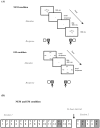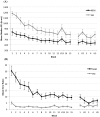Does consolidation of visuospatial sequence knowledge depend on eye movements?
- PMID: 25089701
- PMCID: PMC4121143
- DOI: 10.1371/journal.pone.0103421
Does consolidation of visuospatial sequence knowledge depend on eye movements?
Abstract
In the current study, we assessed whether visuospatial sequence knowledge is retained over 24 hours and whether this retention is dependent on the occurrence of eye movements. Participants performed two sessions of a serial reaction time (SRT) task in which they had to manually react to the identity of a target letter pair presented in one of four locations around a fixation cross. When the letter pair 'XO' was presented, a left response had to be given, when the letter pair 'OX' was presented, a right response was required. In the Eye Movements (EM) condition, eye movements were necessary to perform the task since the fixation cross and the target were separated by at least 9° visual angle. In the No Eye Movements (NEM) condition, on the other hand, eye movements were minimized by keeping the distance from the fixation cross to the target below 1° visual angle and by limiting the stimulus presentation to 100 ms. Since the target identity changed randomly in both conditions, no manual response sequence was present in the task. However, target location was structured according to a deterministic sequence in both the EM and NEM condition. Learning of the target location sequence was determined at the end of the first session and 24 hours after initial learning. Results indicated that the sequence learning effect in the SRT task diminished, yet remained significant, over the 24 hour interval in both conditions. Importantly, the difference in eye movements had no impact on the transfer of sequence knowledge. These results suggest that the retention of visuospatial sequence knowledge occurs alike, irrespective of whether this knowledge is supported by eye movements or not.
Conflict of interest statement
Figures



References
-
- Cleeremans A, Destrebecqz A, Boyer M (1998) Implicit learning: news from the front. Trends Cogn Sci 2: 406–416. - PubMed
-
- Clegg BA, DiGirolamo GJ, Keele SW (1998) Sequence learning. Trends Cogn Sci 2: 275–281. - PubMed
-
- Nissen MJ, Bullemer P (1987) Attentional requirements of learning: evidence from performance measures. Cogn Psychol 19: 1–32.
-
- Abrahamse EL, Jiménez L, Verwey WB, Clegg BA (2010) Representing serial action and perception. Psychon Bull Rev 17: 603–623. - PubMed
-
- Deroost N, Soetens E (2006) Perceptual or motor learning in SRT tasks with complex sequence structures. Psychol Res 70: 88–102. - PubMed
Publication types
MeSH terms
LinkOut - more resources
Full Text Sources
Other Literature Sources

